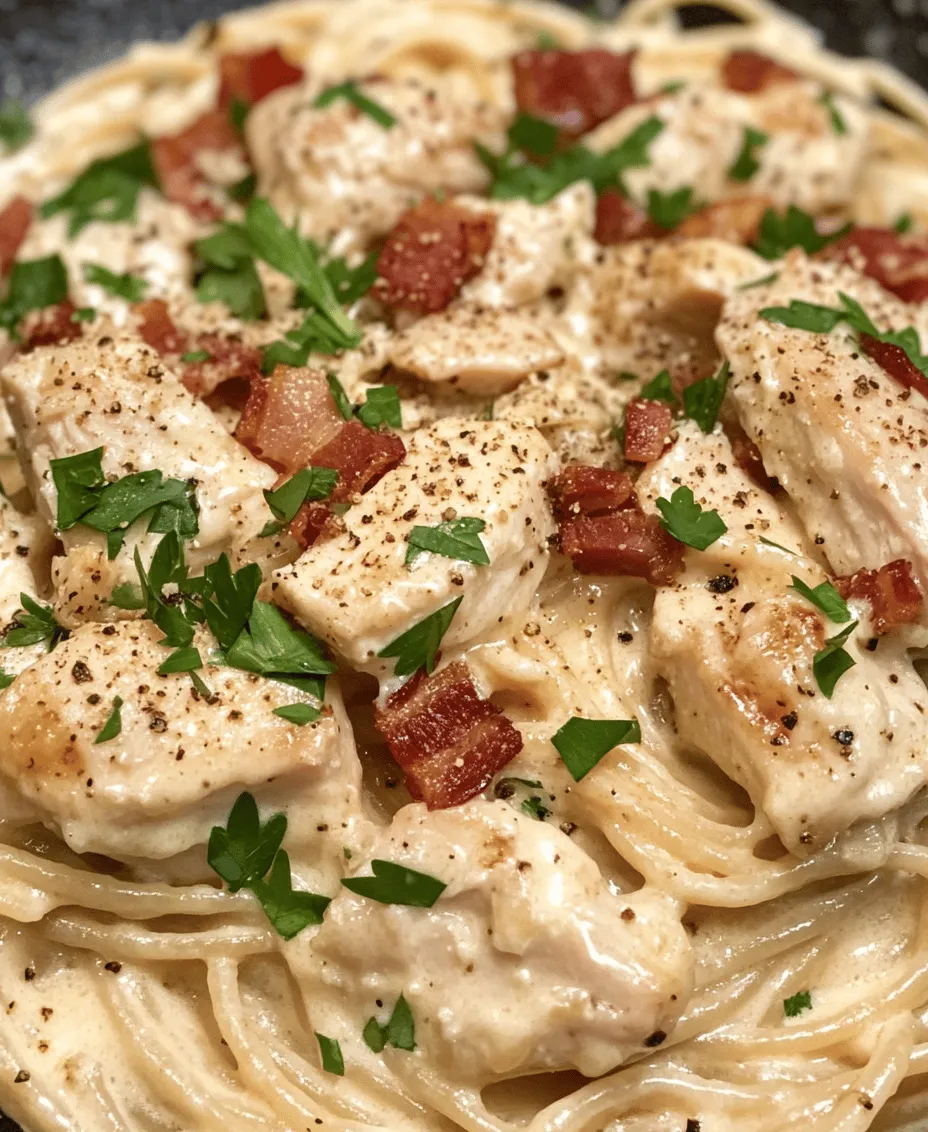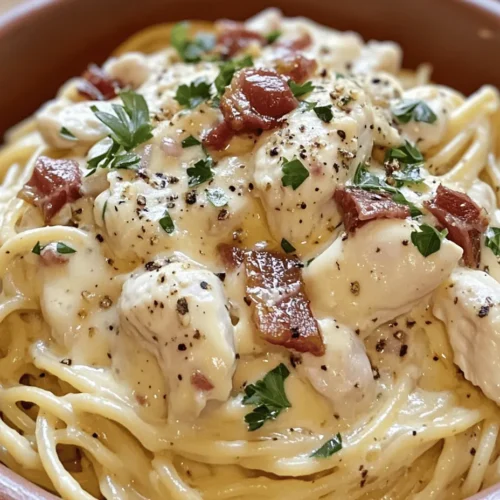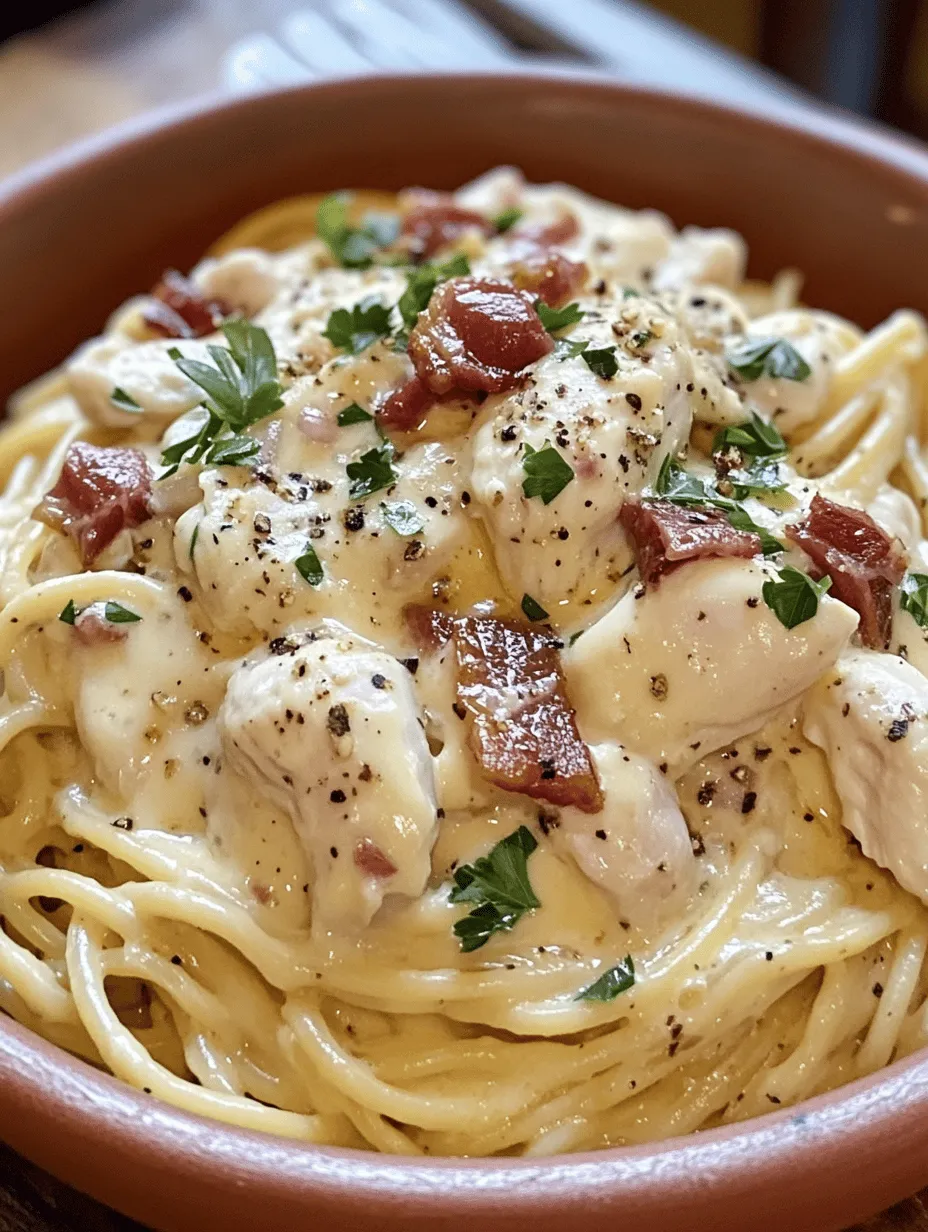Introduction: Exploring the Richness of Chicken Carbonara
In the world of Italian cuisine, few dishes evoke as much warmth and comfort as Chicken Carbonara. This creamy pasta dish, with its rich flavors and simple preparation, has become a favorite among home cooks and gourmet chefs alike. The very essence of Chicken Carbonara lies in its ability to blend everyday ingredients into a stunning meal that satisfies the palate and warms the heart. Whether you are a busy parent looking for a quick weeknight dinner or someone eager to impress guests with culinary skills, Chicken Carbonara offers the perfect solution.
As we embark on this culinary journey, we will delve into the origins of Carbonara, the key ingredients that elevate its flavor, and provide you with an easy-to-follow, step-by-step guide to creating the best-ever Chicken Carbonara in your own kitchen. With a little love and the right techniques, you can master this Italian classic and make it a staple of your home dining experience.
The Origins of Carbonara: A Culinary Journey
Understanding the history of Carbonara enhances our appreciation for the dish. The origins of Carbonara are somewhat ambiguous, with various theories circulating about its beginnings. Most culinary historians agree that Carbonara traces back to Roman cuisine, specifically the Lazio region of Italy. However, the exact timeline and circumstances surrounding its invention remain a topic of debate.
One popular theory suggests that Carbonara was created by Italian charcoal workers, known as “carbonai,” who would prepare the dish using readily available ingredients like eggs, cheese, and cured pork. This rustic preparation method has led many to believe that the dish was originally a simple meal that could be cooked over an open flame.
Traditionally, Carbonara is made with guanciale, a type of cured meat made from pork cheek or jowl. However, in many variations, including Chicken Carbonara, pancetta is often used as a substitute. The evolution of Carbonara reflects the adaptability of Italian cuisine; as it traveled beyond Italy, it absorbed influences from different cultures and contemporary tastes.
Key Ingredients that Make the Best-Ever Chicken Carbonara
The success of Chicken Carbonara hinges on selecting high-quality ingredients. Each element plays a vital role in contributing to the overall flavor and texture of the dish. Here, we explore the key components that elevate Chicken Carbonara from a simple pasta dish to an unforgettable culinary experience.
Exploring the Role of Spaghetti: Why Pasta Choice Matters
When it comes to Carbonara, the choice of pasta is crucial. While traditional recipes often call for spaghetti, you can also experiment with other long pasta types like fettuccine or linguine. The key is to select a pasta that can hold onto the creamy sauce and enhance the dish’s overall texture.
For the best results, opt for high-quality, durum wheat pasta. This type of pasta has a firm texture that holds up well during cooking and allows for a perfect al dente bite, essential for a satisfying Carbonara experience.
Chicken: Choosing the Best Cuts for Flavor and Texture
In Chicken Carbonara, the chicken is the star of the show. Selecting the right cut of chicken is essential to achieving the desired flavor and texture. Boneless, skinless chicken breasts are a popular choice due to their lean nature and adaptability. However, for a richer flavor, consider using chicken thighs, which are juicier and more forgiving during cooking.
Regardless of the cut you choose, it’s important to season the chicken well with salt and pepper before cooking. This simple step enhances the overall flavor of the dish and ensures that every bite is succulent and delicious.
The Importance of Cured Meats: Pancetta and Guanciale Explained
Cured meats are a hallmark of Carbonara, providing depth and richness to the dish. While traditional Carbonara relies on guanciale, Chicken Carbonara often incorporates pancetta as a more accessible alternative.
Pancetta is made from pork belly and offers a slightly sweet and nutty flavor. Its fat content renders beautifully when cooked, creating a flavorful base for the sauce. If you can find guanciale, it is worth the effort, as its unique flavor profile elevates the dish to another level.
Regardless of the cured meat you choose, ensure that it is diced into small pieces to facilitate even cooking and distribution of flavor throughout the pasta.
Cheese Selection: Pecorino Romano vs. Parmesan
No Carbonara is complete without cheese, which adds creaminess and a savory finish. The traditional choice is Pecorino Romano, a hard sheep’s milk cheese with a sharp, tangy flavor. It complements the richness of the cured meats and enhances the overall taste profile of the dish.
However, if Pecorino Romano is not available, freshly grated Parmesan cheese can be used as a substitute. While it has a milder flavor than Pecorino, it still provides a deliciously creamy texture that binds the sauce together. For the best results, always use freshly grated cheese, as pre-grated varieties often contain anti-caking agents that can affect the sauce’s consistency.
Fresh Garlic: The Aromatic Backbone of the Dish
Garlic is an essential ingredient in Chicken Carbonara, providing aromatic depth and enhancing the overall flavor profile. Using fresh garlic cloves, rather than pre-minced or powdered options, ensures that you capture the full essence of this fragrant ingredient.
When preparing your Chicken Carbonara, mince the garlic finely to release its oils and flavors. Sautéing the garlic with the cured meats allows it to mellow and infuse the dish with its aromatic qualities, creating a delicious foundation for the creamy sauce.
The Significance of Fresh Herbs: Parsley as a Garnish
While not traditionally included in the sauce itself, fresh herbs play a crucial role in finishing the dish. Parsley is the herb of choice for garnishing Chicken Carbonara, adding a pop of color and freshness that balances the richness of the sauce.
Chop the parsley finely and sprinkle it over the finished dish just before serving. This simple step not only enhances the visual appeal of the plate but also adds a layer of freshness that elevates the entire meal.
Step-by-Step Guide to Making Chicken Carbonara
Creating the best-ever Chicken Carbonara requires attention to detail and a few simple steps. With this comprehensive walkthrough of the cooking process, even novice cooks can succeed in preparing this beloved Italian classic.
Preparing the Pasta: Tips for Achieving Perfect Al Dente Spaghetti
The first step in making Chicken Carbonara is preparing the pasta. Begin by bringing a large pot of salted water to a rolling boil. The salt is crucial, as it enhances the flavor of the pasta as it cooks.
Once the water is boiling, add the spaghetti and cook according to the package instructions, typically for about 8 to 10 minutes. Remember to stir occasionally to prevent sticking. To achieve the perfect al dente texture, taste the pasta a minute or two before the recommended cooking time. The spaghetti should be firm to the bite but not hard.
When the pasta is cooked to your liking, reserve about a cup of the pasta cooking water and then drain the spaghetti in a colander. Do not rinse the pasta, as the starch on its surface helps the sauce adhere better.
Cooking the Chicken: A Flavorful Base
While the pasta is cooking, you can focus on preparing the chicken. Heat a large skillet over medium heat and add a drizzle of olive oil. Once the oil is shimmering, add the diced chicken. Season with salt and pepper to taste.
Cook the chicken for about 6 to 8 minutes, stirring occasionally, until it is golden brown and cooked through. The internal temperature of the chicken should reach 165°F (75°C) for safety. Once cooked, remove the chicken from the skillet and set it aside on a plate.
Sautéing the Cured Meat: Building Flavor
In the same skillet used for the chicken, add the diced pancetta or guanciale. Cook over medium heat for about 4 to 5 minutes until the meat is crispy and has rendered its fat. This process not only adds flavor but also creates a delicious base for the sauce.
Once the cured meat is cooked, add the minced garlic to the skillet. Sauté for about 30 seconds, just until the garlic is fragrant but not browned. This quick cooking time ensures that the garlic retains its fresh flavor without becoming bitter.
Combining the Ingredients: The Creamy Sauce
With the chicken and cured meat cooked to perfection, it’s time to bring everything together. Add the drained spaghetti to the skillet, tossing it with the pancetta and garlic to coat the pasta in the flavorful fat.
Next, remove the skillet from the heat to prevent the eggs from scrambling in the next step. In a bowl, whisk together the eggs, grated Pecorino Romano cheese, and a splash of the reserved pasta water. The heat from the pasta will gently cook the eggs, creating a creamy sauce that clings to every strand of spaghetti.
Pour the egg mixture over the pasta, tossing quickly to combine. If the sauce appears too thick, add a little more reserved pasta water until you reach your desired consistency. The result should be a silky, creamy Carbonara sauce that envelops the chicken and pasta effortlessly.
As you can see, Chicken Carbonara is not just a meal; it is a celebration of flavors and textures that can transport you to the heart of Italy with each bite. In the next part of this article, we will explore additional tips for achieving the perfect Chicken Carbonara and address some common questions that may arise during the cooking process. Stay tuned for a culinary adventure that will make you a Carbonara aficionado in no time!

Cooking the Chicken: Techniques for Juicy, Flavorful Pieces
To achieve the best-ever Chicken Carbonara, the first step is to cook the chicken perfectly. Juicy, flavorful chicken not only enhances the dish but also adds a satisfying texture. Begin with boneless, skinless chicken breasts or thighs, as they are tender and cook quickly.
1. Season Generously: Start by seasoning your chicken liberally with salt and freshly cracked black pepper. You can also add garlic powder or Italian seasoning for an extra flavor boost.
2. Searing Technique: Heat a large skillet over medium-high heat and add a tablespoon of olive oil. Once the oil is hot and shimmering, add the chicken pieces. Searing the chicken creates a beautiful golden crust, locking in moisture and flavor.
3. Cooking Time: Cook the chicken for about 6-7 minutes on one side without moving it, allowing it to develop a nice crust. Flip it over and cook for another 5-6 minutes until the internal temperature reaches 165°F (75°C). This ensures the chicken is cooked through yet remains juicy.
4. Resting Period: Allow the chicken to rest for at least 5 minutes before slicing. This step is crucial as it lets the juices redistribute, resulting in tender slices that won’t dry out when added to the carbonara.
Sautéing the Pancetta: Achieving the Ideal Crispness
Pancetta is a key ingredient in Chicken Carbonara, providing a rich, savory flavor. Here’s how to prepare it perfectly:
1. Choosing Pancetta: Look for high-quality pancetta that is thickly sliced. It should be slightly fatty, which will render down during cooking, adding flavor to the dish.
2. Sautéing Process: In the same skillet used for the chicken (after removing it), add another tablespoon of olive oil if necessary. Place the pancetta in the skillet over medium heat. Cook it for about 5-7 minutes, stirring occasionally, until it is golden brown and crispy.
3. Flavor Development: The rendered fat from the pancetta becomes a flavorful base for the carbonara sauce. Be sure not to overcook it to avoid bitterness; a crisp texture is desired without burning.
Crafting the Sauce: Balancing Eggs and Cheese for Creaminess
The creamy sauce is what makes Chicken Carbonara so indulgent. Achieving the right balance is essential for the perfect texture and flavor.
1. Ingredient Preparation: While the pancetta cooks, whisk together 3 large eggs and a generous amount of freshly grated Parmesan cheese (about 1 cup). Adding a pinch of salt and freshly cracked black pepper will enhance the flavor.
2. Heat Control: Once the pancetta is cooked, remove the skillet from the heat before adding the egg mixture. The residual heat from the pan will be sufficient to cook the eggs gently, creating a silky sauce without scrambling.
3. Combining Eggs and Cheese: Pour the egg and cheese mixture into the skillet containing the pancetta, stirring quickly to combine. The heat will thicken the sauce and coat the pasta beautifully.
Combining the Elements: Ensuring Even Coating and Texture
Now that you have cooked chicken and pancetta and prepared your sauce, it’s time to bring everything together.
1. Cook the Pasta: In a separate pot, cook your spaghetti or fettuccine according to package instructions. Ensure you reserve about a cup of pasta cooking water before draining the pasta.
2. Merging Ingredients: Add the drained pasta to the skillet with the pancetta and sauce. Toss everything together, ensuring that the pasta is coated evenly. If the sauce is too thick, add a splash of the reserved pasta water to loosen it up.
3. Incorporating Chicken: Slice the rested chicken and add it to the pasta. Toss gently to combine, ensuring each bite is infused with the rich flavors of the sauce and pancetta.
Final Touches: Adjusting Seasoning and Presentation
The final touches are crucial to elevate your Chicken Carbonara.
1. Taste Testing: Before serving, taste the dish to adjust seasoning. You may want to add more salt, pepper, or cheese based on your preference.
2. Garnishing: Transfer the Carbonara to serving plates or a large bowl. Garnish with additional grated Parmesan cheese and a sprinkle of freshly chopped parsley or basil for a pop of color.
3. Presentation: Serve immediately, as Carbonara is best enjoyed fresh. The creamy sauce will thicken as it cools, so prompt serving is ideal.
Understanding the Science Behind the Creamy Sauce
A well-crafted carbonara sauce is a testament to the beauty of culinary techniques. Understanding the science behind it can help you master this dish.
The Role of Residual Heat in Cooking Eggs: When making carbonara, the residual heat from the pasta and pancetta is what cooks the eggs gently. This prevents scrambling and allows the sauce to achieve its creamy consistency.
How to Avoid Scrambling: Timing and Technique: Timing is critical. By removing the skillet from the heat before adding eggs, you control the cooking temperature. Stirring quickly also helps integrate the eggs into the sauce without allowing them to curdle.
The Emulsification Process: The combination of eggs, cheese, and rendered fat from the pancetta creates an emulsion, resulting in a smooth sauce. The starch from the pasta also aids in this process, enhancing the sauce’s creaminess.
The Balance of Flavors: The saltiness from the pancetta and cheese pairs beautifully with the richness of the egg. This balance is essential to prevent the dish from becoming overly heavy or bland.
Serving and Enjoying Chicken Carbonara
Presentation and serving suggestions play a significant role in enhancing your dining experience.
Ideal Serving Sizes and Portioning: For a satisfying meal, serve about 1.5 to 2 cups of Chicken Carbonara per person. This portion size allows guests to enjoy the dish without overwhelming them.
Pairing Suggestions: A well-chosen wine can elevate your Chicken Carbonara experience. Look for a crisp white wine such as Pinot Grigio or a light red like Chianti. Both options complement the rich flavors of the dish without overpowering it.
Side Dishes: To round out your meal, consider serving a simple arugula salad with a lemon vinaigrette to cut through the richness of the Carbonara. Garlic bread or a light vegetable sauté can also be delightful accompaniments.
Conclusion: Savoring the Comfort of Homemade Chicken Carbonara
Creating the best-ever Chicken Carbonara is not just about following a recipe; it’s about embracing a culinary tradition that celebrates simplicity and flavor. With the right ingredients and techniques, anyone can replicate this classic dish in their own kitchen, bringing a taste of Italy to the dining table.
As you enjoy your homemade Chicken Carbonara, take a moment to appreciate the rich history and cultural significance behind each bite. This dish embodies comfort and indulgence, making it a perfect choice for family dinners or special occasions. Whether you’re a seasoned cook or a novice in the kitchen, this recipe invites you to savor the joy of cooking and sharing delicious food with loved ones.



